ATLFAST CORRECTORS VERSION 15.6.1.2 FOR 10TEV
Efficiencies and Contaminations
I have produced a revised set of efficiencies and contaminations for e, gamma and jets using athena version 15.6.1.2. Here I will present the new efficiencies and investigate the cause of efficiencies and contaminations changes. I will start by giving details on how to produce the efficiencies and contaminations.
Producing Efficiencies and Contaminations
Checking Out And Setting Up AnalysisSkeleton.py
Before we can produce the efficiencies and contaminations we must check out the effmisid package. Once you have set up CMT and CVS we can checkout effmisid package (consult logfile ATLFAST-EFF-CON.txt for a quick guide on how to do this).
When checking out effmisid remember to make a new directory to check effmisid into.
Once effmisid is checked out you will find the following files.
- Analysis2.cxx
- Analysis2.h
- AnalysisSkeleton.cxx
- AnalysisSkeleton.h
- mytry.C
- mytry_eta.C
- AnalysisSkeleton_jobOptions.py
I will describe briefly the purpose of the files. Analysis2.cxx and Analysis2.h create histograms of the ntuples from the truth and reconstructed containers. mytry.C and mytry_eta.C plot the efficiencies and contaminations from the histograms. mytry.C and mytry_eta.C also produces the .dat files that are used in AtlfastC.
AnalysisSkeleton.cxx and AnalysisSkeleton.h are responsible for making the ntuple from a AOD dataset (e.g. Z->ee). You must copy these two files to src and UserAnalysis directories in the athena PhysicsAnalysis package you set up. Once These files are copied, compile CMT by using
CMT bro gmake
. We are now ready to run athena with our new AnalysisSkeleton. First, we must copy AnalysisSkeleton_jobOptions.py to our run directory.
- IMPORTANT- You will have to included a bug fix in the AnalysisSkeleton_jobOptions.py, as the container name for Tower jets has change in version 15 from version 14. The line of code that you have to insert is shown below.
import JetRec.ParticleJetCompatibility
We can now run over a sample and start to produce efficiencies. I have included a logfile below that outlines the steps for producing efficiencies.
Electron Efficiencies and Contaminations using a Z->ee dataset
The efficiencies presented here are produced using version 15.6.1.2 of athena. I will compare these efficiencies with version 14.5.0 efficiencies produced by Catherine Wright and version 15 efficiencies from the e/gamma group.
Loose Electrons
Fig 1.1
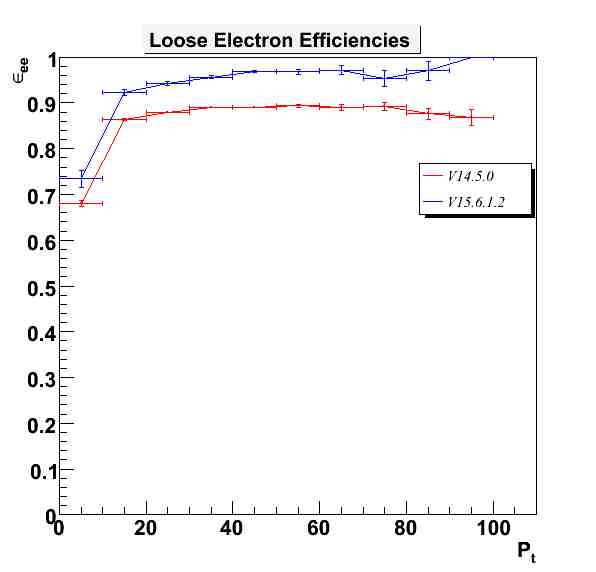
Fig 1.2

Fig 1.3

Fig 1.4

Fig1.5

Fig 1.6

Fig1.7

Fig1.8

Medium Electrons
Fig2.1

Fig2.2

Fig2.3

Fig2.4

Fig2.5

Fig2.6

Fig2.7

Fig2.8

Tight Electrons
Fig3.1

Fig3.2

Fig3.3

Fig3.4

Fig3.5

Fig3.6

Fig3.7

Fig3.8

Non Isolated Electron Efficiencies and Contaminations using a ttbar dataset
Loose Electrons
Fig4.1

Fig4.2
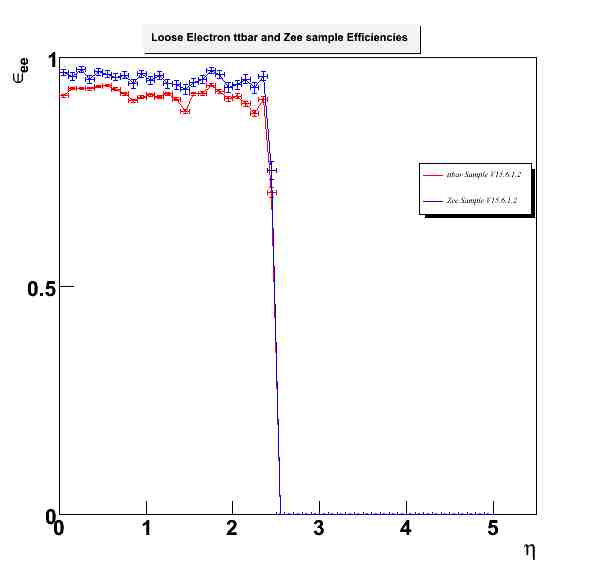
Fig4.3

Fig4.4

Fig4.5

Fig4.6

Fig4.7

Fig4.8

Medium Electrons
Fig5.1

Fig5.2

Fig5.3

Fig5.4

Fig5.5
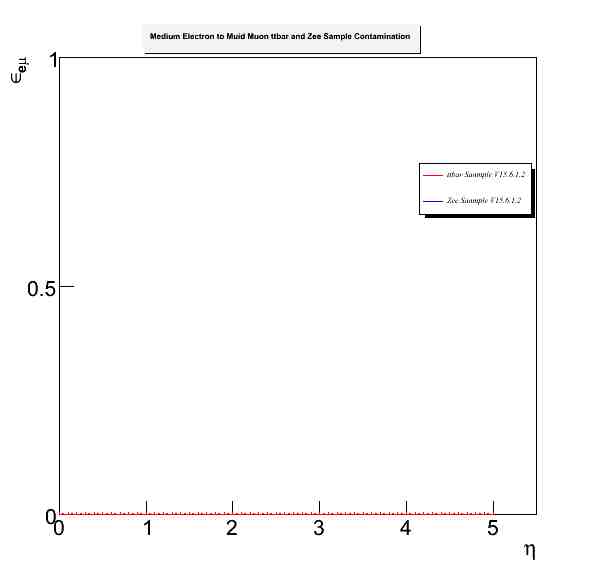
Fig5.6

Fig5.7

Fig5.8

Tight Electrons
Fig6.1

Fig6.2

Fig6.3

Fig6.4

Fig6.5

Fig6.6
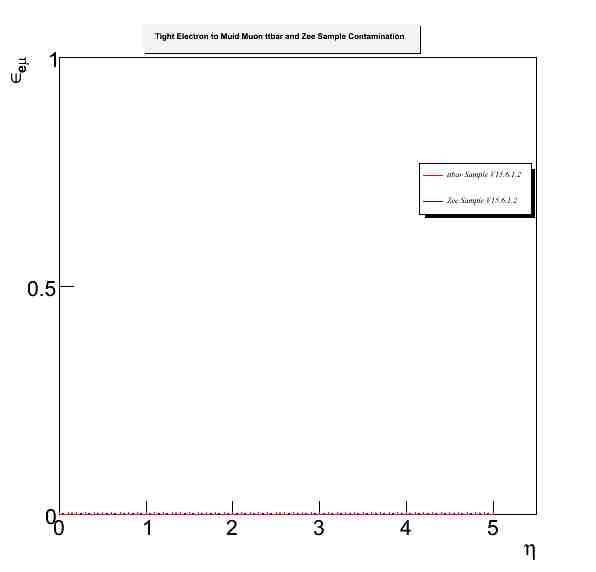
Fig6.7

Fig6.8

Isolated Electron Efficiencies and Contaminations using a ttbar dataset
Loose Electrons
Fig4.1

Fig4.2

Fig4.3

Fig4.4

Fig4.5

Fig4.6

Fig4.7

Fig4.8

Medium Electrons
Fig5.1

Fig5.2
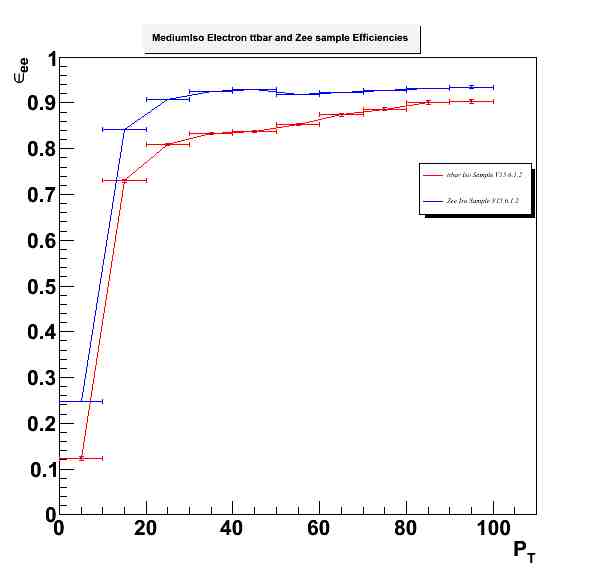
Fig5.3

Fig5.4

Fig5.5

Fig5.6

Fig5.7

Fig5.8

Tight Electrons
Fig6.1

Fig6.2

Fig6.3

Fig6.4

Fig6.5

Fig6.6

Fig6.7

Fig6.8

Photon Efficiencies and Contaminations using a H->gamgam dataset
Photon Efficiency
Fig7.1
 Fig7.2
Fig7.2 
Photon to Electron Contamination
Fig8.1 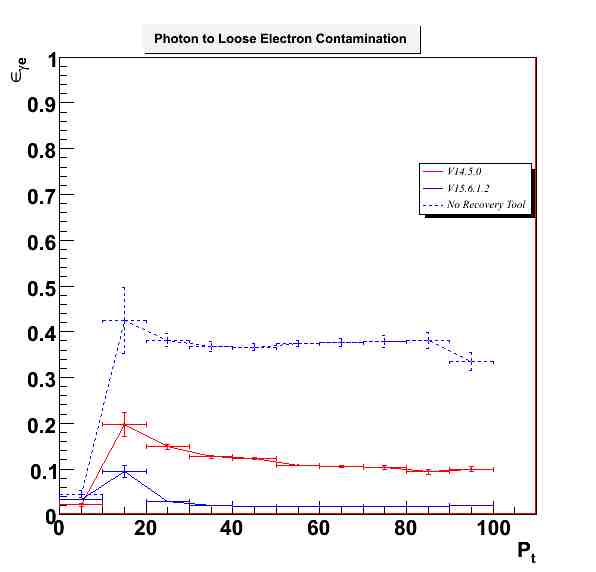 Fig8.2
Fig8.2  Fig8.3
Fig8.3  Fig8.4
Fig8.4  Fig8.5
Fig8.5  Fig8.6
Fig8.6 
Photon to C4 Jet Contamination
Fig9.1  Fig9.2
Fig9.2 
Photon to Muid Muon Contamination
Fig10.1  Fig10.2
Fig10.2 
C4 Jet Efficiencies and Contaminations using JetJet datasets
C4 Jet Efficiency
Fig11.1  Fig11.2
Fig11.2 
C4 Jet to Electron Contamination
Fig12.1  Fig12.2
Fig12.2  Fig12.3
Fig12.3  Fig12.4
Fig12.4  Fig12.5
Fig12.5  Fig12.6
Fig12.6 
C4 Jet to Photon Contamination
Fig13.1  Fig13.2
Fig13.2 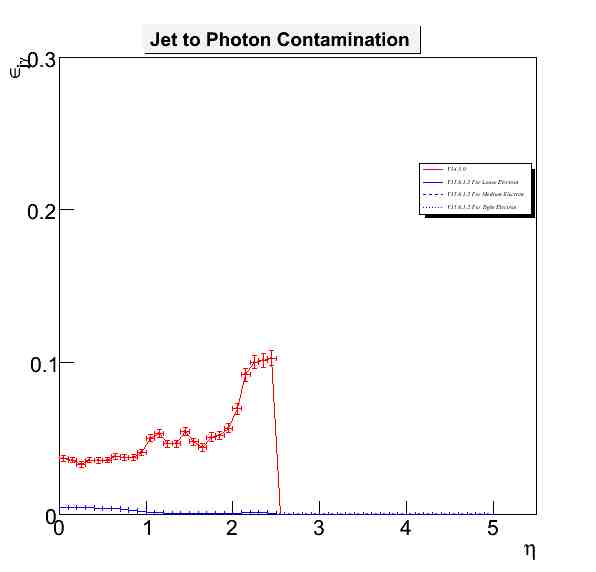
C4 Jet to Muid Muon Contamination
Fig14.1  Fig14.2
Fig14.2 
Changes To Electron Definition From Athena V14.5.0 To V15.6.1.2
Validation: Electron Efficiency
The medium isolated electron Efficiency is applied to ttbar events generated by the AcerMC Monte Carlo generator.
All (Non Isolated) Electrons
FULL (blue), FAST (red) and CORRECTED FAST (green)
- Fig 15.4, 15.5, 15.6 are Non Isolated leading electrons
Fig15.1  Fig15.2
Fig15.2  Fig15.3
Fig15.3  Fig15.4
Fig15.4  Fig15.5
Fig15.5  Fig15.6
Fig15.6 
Isolated Electrons
FULL (blue), FAST (red) and CORRECTED FAST (green)
- Fig 16.4, 16.5, 16.6 are Isolated leading electrons
Fig16.1 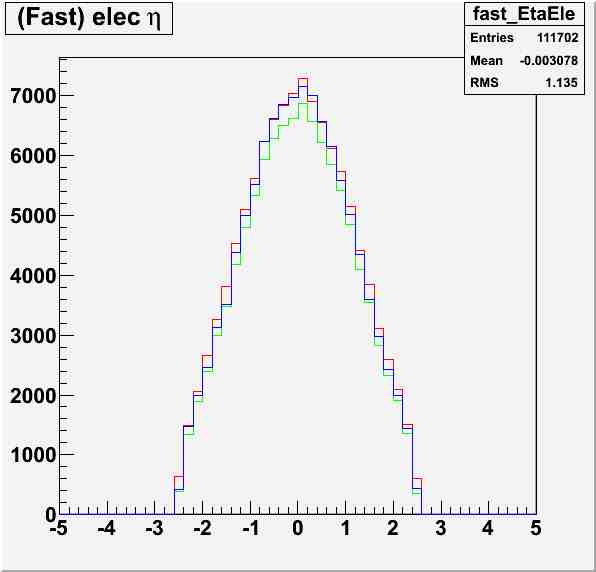 Fig16.2
Fig16.2  Fig16.3
Fig16.3  Fig16.4
Fig16.4  Fig16.5
Fig16.5 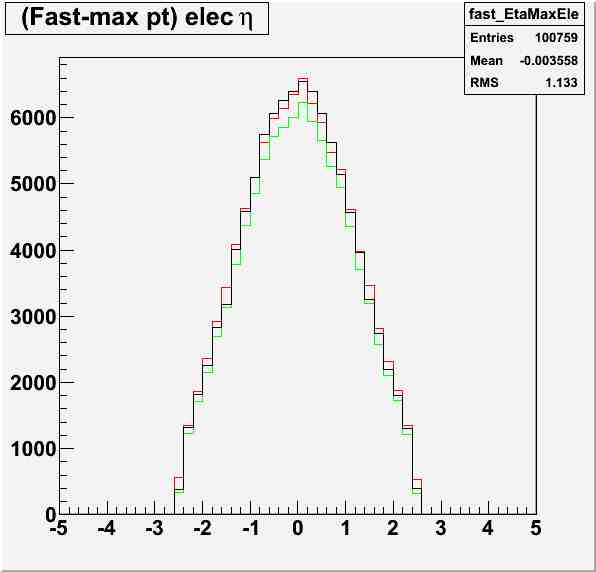 Fig16.6
Fig16.6 
Ratio of Fast and Full Simulation
All (Non Isolated) Electrons
Fig17.1  Fig17.2
Fig17.2 
Isolated Electrons
Fig18.1  Fig18.2
Fig18.2 
Average of Electron Efficiencies in Eta and Pt
Zee Electron Efficiencies
| Loose |
Medium |
Tight |
No Hard Cut Medium Electron |
| 95.221 +/- 0.431 |
90.558 +/- 0.029 |
78.819 +/- 0.053 |
91.789 +/- 0.065 |
ttbar Electron Efficiencies
| Loose |
Medium |
Tight |
No Hard Cut Medium Electron |
| 91.522 +/- 0.184 |
81.923 +/- 0.250 |
69.075 +/- 0.298 |
88.569 +/- 0.585 |
Timing Study
A timing Study for Atlfast and AtlfastC was carried out in Version 14.5.0 and Version 15.6.1.2. The samples used in this study where ttbar and Z->ee EVGEN samples. The EVGEN datasets where then put into POOLtoAtlfasttoAOD.py job option that produces an Atlfast AOD. With the AOD we create a corrected AOD using AtlfastC_AODtoAOD.py job option, resulting in an AOD with applied efficiencies to replicate the full simulation AODs.
It must also be noted that we can use the PythiatoAtlfasttoAOD.py job option to produce an Atlfast AOD.
Running POOLtoAtlfasttoAOD.py To Produce Timings
I will now discuss the steps that were taken to produce an Atlfast AOD and the changes to POOLtoAtlfasttoAOD.py to produce the timings (I have included a Logfile
below to show the method used).
Changes to POOLtoAtlfasttoAOD.py
- Remember only EVGEN datasets can be read into POOLtoAtlfasttoAOD.py.
- Input dataset to Atlfast_ReadPOOLFile.py, which is located in POOLtoAtlfasttoAOD.py (need to get_file Atlfast_ReadPOOLFile.py)
- Add ChronoStat service at the end of POOLtoAtlfasttoAOD.py (This outputs the running time of Atlfast and all the Algorithms used).
from AthenaCommon.ConfigurableDb import getConfigurable
# --- write out summary of the memory usage
# | number of events to be skip to detect memory leak
# | 20 is default. May need to be made larger for complete jobs.
ServiceMgr.AuditorSvc += getConfigurable("ChronoAuditor")()
# --- write out a short message upon entering or leaving each algorithm
theApp.AuditAlgorithms = True
theApp.AuditServices = True
ServiceMgr.AthenaPoolCnvSvc.UseDetailChronoStat = True
theAuditorSvc.Auditors += [ "NameAuditor" ]
ChronoStatSvc = Service ( "ChronoStatSvc")
Running AtlfastC_AODtoAOD.py To Produce Timings
The steps taken to produce an AtlfastC AOD and timings are discussed
here .
Changes to AtlfastC_AODtoAOD.py
- Edit the input of AtlfastC_AODtoAOD.py to the output of POOLtoAtlfasttoAOD.py.
Timing Table
Results of the Timing Study
| Version |
Sample |
Atlfast |
AtlfastC (Algs Off) |
AtlfastC (Algs On) |
| 14.5.0 |
Zee |
0.3708 [s] |
0.1080 [s] |
|
| 15.6.1.2 |
Zee |
0.3762 [s] |
0.0939 [s] |
0.1273 [s] |
| 14.5.0 |
ttbar |
0.3048 [s] |
0.1782 [s] |
|
| 15.6.1.2 |
ttbar |
0.2784 [s] |
0.1758 [s] |
0.1902 [s] |
Note:
- AtlfastC (Algs Off) refers to the same correctors ran for version 14 and 15
- AtlfastC (Algs On) refers to additional correctors for jets and muons ran in version 15 only.
Number of Algorithms Ran In Atlfast
| Version |
AtlFast Algs |
| V14 |
268 |
| V15 |
286 |
Atlfast:execute Timings
| Sample |
Atlfast:exe |
| V14 Z->ee |
26 [ms] |
| V15 Z->ee |
25.9 [ms] |
| V14 ttbar |
40 [ms] |
| V15 ttbar |
34.3 [ms] |
Note:
- Atlfast:exe shows us specifically how long it took Atlfast to run i.e. no timings for I/O and Atlfast Algorithms
Number of Algorithms in Atlfast-C
| Version |
Algs In Atlfast-C |
| V14 |
175 |
| V15 Algs Off |
179 |
| V15 Algs On |
203 |
Number of Algorithms in Atlfast Plus Correctors
| Version |
Numbe of Algorithms |
| V15 Atlfast Plus Correctors |
346 |
Is It quicker to run Atlfast Plus Correctors
| Sample |
Atlfast + Atlfast-C |
Atlfast Plus Correctors |
Diff (col2-Col3) |
| V15 Z->ee |
0.5035 [s] |
0.4539 [s] |
0.0496 [s] |
| V15 ttbar |
0.4686 [s] |
0.4032 [s] |
0.0654 [s] |
As Predicted, running the correctors within Atlfast is quicker than making two separate AODs.
Overview
- Atlfast-C is quicker at producing a AOD in version 15 than version 14.
- Atlfast V14 and V15 take similar times to run. This is Also true when running ttbar and Zee samples.
- Atlfast:execute is faster in the Zee sample than ttbar sample, as expected (this is due to the length of time taken for the truth jet algorithm to run in the ttbar sample compared with the Zee sample).
Timing Samples
Information on the EVGEN and AOD datasets.
AMI Z->ee
AMI ttbar
Location of EVGEN datasets
/data/atlas07/mwright/V14-Zee-EVGEN-MIKE/
/data/atlas04/mwright/ATLFAST/ttSamples/
Location of Atlfast AODs
/data/atlas07/mwright/ATLFAST/Timings/Zee/AtlFast/
/data/atlas04/mwright/ATLFAST/ttSamples/ttAtlfastOutput
Running AtlFast And AtlFastC Logfiles
PrintOut
Loose Electrons
Fig 1.1

Fig 1.2

Fig 1.3

Fig 1.4

Fig1.5

Fig 1.6

Fig1.7

Fig1.8

Medium Electrons
Fig2.1

Fig2.2

Fig2.3

Fig2.4

Fig2.5

Fig2.6

Fig2.7

Fig2.8

Tight Electrons
Fig3.1

Fig3.2

Fig3.3

Fig3.4

Fig3.5

Fig3.6

Fig3.7

Fig3.8

Isolated Electron Efficiencies and Contaminations using a ttbar dataset
Loose Electrons
Fig4.1

Fig4.2

Fig4.3

Fig4.4

Fig4.5

Fig4.6

Fig4.7

Fig4.8

Medium Electrons
Fig5.1

Fig5.2

Fig5.3

Fig5.4

Fig5.5

Fig5.6

Fig5.7

Fig5.8

Tight Electrons
Fig6.1

Fig6.2

Fig6.3

Fig6.4

Fig6.5

Fig6.6

Fig6.7

Fig6.8

Non Isolated Electron Efficiencies and Contaminations using a ttbar dataset
Loose Electrons
Fig4.1

Fig4.2

Fig4.3

Fig4.4

Fig4.5

Fig4.6

Fig4.7

Fig4.8

Medium Electrons
Fig5.1

Fig5.2

Fig5.3

Fig5.4

Fig5.5

Fig5.6

Fig5.7

Fig5.8

Tight Electrons
Fig6.1

Fig6.2

Fig6.3

Fig6.4

Fig6.5

Fig6.6

Fig6.7

Fig6.8

Photon Efficiencies and Contaminations using a H->gamgam dataset
Photon Efficiency
Fig7.1
 Fig7.2
Fig7.2 
Photon to Electron Contamination
Fig8.1  Fig8.2
Fig8.2  Fig8.3
Fig8.3  Fig8.4
Fig8.4  Fig8.5
Fig8.5  Fig8.6
Fig8.6 
Photon to C4 Jet Contamination
Fig9.1  Fig9.2
Fig9.2 
Photon to Muid Muon Contamination
Fig10.1  Fig10.2
Fig10.2 
All (Non Isolated) Electrons
FULL (blue), FAST (red) and CORRECTED FAST (green)
- Fig 15.4, 15.5, 15.6 are Non Isolated leading electrons
Fig15.1  Fig15.2
Fig15.2  Fig15.3
Fig15.3  Fig15.4
Fig15.4  Fig15.5
Fig15.5  Fig15.6
Fig15.6 
Isolated Electrons
FULL (blue), FAST (red) and CORRECTED FAST (green)
- Fig 16.4, 16.5, 16.6 are Isolated leading electrons
Fig16.1  Fig16.2
Fig16.2  Fig16.3
Fig16.3  Fig16.4
Fig16.4  Fig16.5
Fig16.5  Fig16.6
Fig16.6  -- MichaelWright
-- MichaelWright - 2010-03-03
 Fig 1.2
Fig 1.2 Fig 1.3
Fig 1.3  Fig 1.4
Fig 1.4  Fig1.5
Fig1.5  Fig 1.6
Fig 1.6  Fig1.7
Fig1.7  Fig1.8
Fig1.8 
 Fig2.2
Fig2.2 Fig2.3
Fig2.3  Fig2.4
Fig2.4  Fig2.5
Fig2.5  Fig2.6
Fig2.6 Fig2.7
Fig2.7  Fig2.8
Fig2.8 
 Fig3.2
Fig3.2  Fig3.3
Fig3.3 Fig3.4
Fig3.4 Fig3.5
Fig3.5  Fig3.6
Fig3.6  Fig3.7
Fig3.7  Fig3.8
Fig3.8 
 Fig4.2
Fig4.2  Fig4.3
Fig4.3  Fig4.4
Fig4.4  Fig4.5
Fig4.5  Fig4.6
Fig4.6  Fig4.7
Fig4.7  Fig4.8
Fig4.8 
 Fig5.2
Fig5.2  Fig5.3
Fig5.3  Fig5.4
Fig5.4  Fig5.5
Fig5.5  Fig5.6
Fig5.6  Fig5.7
Fig5.7  Fig5.8
Fig5.8 
 Fig6.2
Fig6.2  Fig6.3
Fig6.3  Fig6.4
Fig6.4  Fig6.5
Fig6.5  Fig6.6
Fig6.6  Fig6.7
Fig6.7  Fig6.8
Fig6.8 
 Fig4.2
Fig4.2  Fig4.3
Fig4.3  Fig4.4
Fig4.4  Fig4.5
Fig4.5  Fig4.6
Fig4.6  Fig4.7
Fig4.7  Fig4.8
Fig4.8 
 Fig5.2
Fig5.2  Fig5.3
Fig5.3  Fig5.4
Fig5.4  Fig5.5
Fig5.5  Fig5.6
Fig5.6  Fig5.7
Fig5.7  Fig5.8
Fig5.8 
 Fig6.2
Fig6.2  Fig6.3
Fig6.3  Fig6.4
Fig6.4  Fig6.5
Fig6.5  Fig6.6
Fig6.6  Fig6.7
Fig6.7  Fig6.8
Fig6.8 
 Fig7.2
Fig7.2 
 Fig8.2
Fig8.2  Fig8.3
Fig8.3  Fig8.4
Fig8.4  Fig8.5
Fig8.5  Fig8.6
Fig8.6 
 Fig9.2
Fig9.2 
 Fig10.2
Fig10.2 
 Fig11.2
Fig11.2 
 Fig12.2
Fig12.2  Fig12.3
Fig12.3  Fig12.4
Fig12.4  Fig12.5
Fig12.5  Fig12.6
Fig12.6 
 Fig13.2
Fig13.2 
 Fig14.2
Fig14.2 
 Fig15.2
Fig15.2  Fig15.3
Fig15.3  Fig15.4
Fig15.4  Fig15.5
Fig15.5  Fig15.6
Fig15.6 
 Fig16.2
Fig16.2  Fig16.3
Fig16.3  Fig16.4
Fig16.4  Fig16.5
Fig16.5  Fig16.6
Fig16.6 
 Fig17.2
Fig17.2 
 Fig18.2
Fig18.2 
 Fig 1.2
Fig 1.2 Fig 1.3
Fig 1.3  Fig 1.4
Fig 1.4  Fig1.5
Fig1.5  Fig 1.6
Fig 1.6  Fig1.7
Fig1.7  Fig1.8
Fig1.8 
 Fig2.2
Fig2.2 Fig2.3
Fig2.3  Fig2.4
Fig2.4  Fig2.5
Fig2.5  Fig2.6
Fig2.6 Fig2.7
Fig2.7  Fig2.8
Fig2.8 
 Fig3.2
Fig3.2  Fig3.3
Fig3.3 Fig3.4
Fig3.4 Fig3.5
Fig3.5  Fig3.6
Fig3.6  Fig3.7
Fig3.7  Fig3.8
Fig3.8 
 Fig4.2
Fig4.2  Fig4.3
Fig4.3  Fig4.4
Fig4.4  Fig4.5
Fig4.5  Fig4.6
Fig4.6  Fig4.7
Fig4.7  Fig4.8
Fig4.8 
 Fig5.2
Fig5.2  Fig5.3
Fig5.3  Fig5.4
Fig5.4  Fig5.5
Fig5.5  Fig5.6
Fig5.6  Fig5.7
Fig5.7  Fig5.8
Fig5.8 
 Fig6.2
Fig6.2  Fig6.3
Fig6.3  Fig6.4
Fig6.4  Fig6.5
Fig6.5  Fig6.6
Fig6.6  Fig6.7
Fig6.7  Fig6.8
Fig6.8 
 Fig4.2
Fig4.2  Fig4.3
Fig4.3  Fig4.4
Fig4.4  Fig4.5
Fig4.5  Fig4.6
Fig4.6  Fig4.7
Fig4.7  Fig4.8
Fig4.8 
 Fig5.2
Fig5.2  Fig5.3
Fig5.3  Fig5.4
Fig5.4  Fig5.5
Fig5.5  Fig5.6
Fig5.6  Fig5.7
Fig5.7  Fig5.8
Fig5.8 
 Fig6.2
Fig6.2  Fig6.3
Fig6.3  Fig6.4
Fig6.4  Fig6.5
Fig6.5  Fig6.6
Fig6.6  Fig6.7
Fig6.7  Fig6.8
Fig6.8 
 Fig7.2
Fig7.2 
 Fig8.2
Fig8.2  Fig8.3
Fig8.3  Fig8.4
Fig8.4  Fig8.5
Fig8.5  Fig8.6
Fig8.6 
 Fig9.2
Fig9.2 
 Fig10.2
Fig10.2 
 Fig15.2
Fig15.2  Fig15.3
Fig15.3  Fig15.4
Fig15.4  Fig15.5
Fig15.5  Fig15.6
Fig15.6 
 Fig16.2
Fig16.2  Fig16.3
Fig16.3  Fig16.4
Fig16.4  Fig16.5
Fig16.5  Fig16.6
Fig16.6  -- MichaelWright - 2010-03-03
-- MichaelWright - 2010-03-03 

